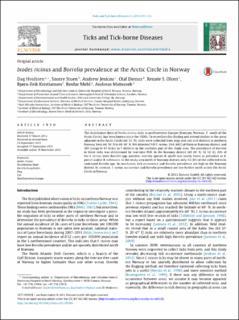Ixodes ricinus and Borrelia prevalence at the Arctic Circle in Norway
Hvidsten, Dag; Stuen, Snorre; Jenkins, Andrew; Dienus, Olaf; Olsen, Renate Slind; Kristiansen, Bjørn-Erik; Mehl, Reidar Arne; Matussek, Andreas
Peer reviewed, Journal article
Published version
Permanent lenke
https://hdl.handle.net/11250/3068499Utgivelsesdato
2014Metadata
Vis full innførselSamlinger
Originalversjon
Hvidsten, D., Stuen, S., Jenkins, A., Dienus, O., Olsen, R. S., Kristiansen, B.-E., Mehl, R. & Matussek, A. (2014). Ixodes ricinus and Borrelia prevalence at the Arctic Circle in Norway. Ticks and Tick-borne Diseases, 5(2), 107-112. https://doi.org/10.1016/j.ttbdis.2013.09.003Sammendrag
The distribution limit of Ixodes ricinus ticks in northwestern Europe (Brønnøy, Norway, 1° south of the Arctic Circle), has been known since the 1930s. To reconfirm this finding and extend studies in the areas adjacent to the Arctic Circle (66°33′ N), ticks were collected from dogs and cats in 8 districts in northern Norway from 64°56′ N to 68°48′ N. We detected 549 I. ricinus, 244 (44%) of them in Brønnøy district, and 305 (range 6–87 ticks) in 7 districts in the northern part of the study area. The prevalence of Borrelia in these ticks was determined by real-time PCR. In the Brønnøy district (65°28′ N, 12°12′ E), 29% of the I. ricinus were Borrelia spp.-positive, and the species B. afzelii was nearly twice as prevalent as B. garinii and/or B. valaisiana. In the study area north of Brønnøy district, only 12 (4%) of the collected ticks contained Borrelia spp. In conclusion, tick occurrence and Borrelia prevalence are high in the Brønnøy district. In contrast, I. ricinus occurrence and Borrelia prevalence are low further north across the Arctic Circle in Norway.

